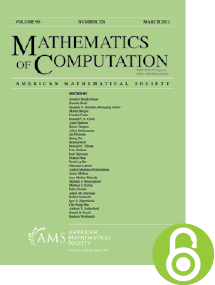$L$-functions and class numbers of imaginary quadratic fields and of quadratic extensions of an imaginary quadratic field
HTML articles powered by AMS MathViewer
- by Stéphane Louboutin PDF
- Math. Comp. 59 (1992), 213-230 Request permission
Abstract:
Starting from the analytic class number formula involving its L-function, we first give an expression for the class number of an imaginary quadratic field which, in the case of large discriminants, provides us with a much more powerful numerical technique than that of counting the number of reduced definite positive binary quadratic forms, as has been used by Buell in order to compute his class number tables. Then, using class field theory, we will construct a periodic character $\chi$, defined on the ring of integers of a field K that is a quadratic extension of a principal imaginary quadratic field k, such that the zeta function of K is the product of the zeta function of k and of the L-function $L(s,\chi )$. We will then determine an integral representation of this L-function that enables us to calculate the class number of K numerically, as soon as its regulator is known. It will also provide us with an upper bound for these class numbers, showing that Hua’s bound for the class numbers of imaginary and real quadratic fields is not the best that one could expect. We give statistical results concerning the class numbers of the first 50000 quadratic extensions of ${\mathbf {Q}}(i)$ with prime relative discriminant (and with K/Q a non-Galois quartic extension). Our analytic calculation improves the algebraic calculation used by Lakein in the same way as the analytic calculation of the class numbers of real quadratic fields made by Williams and Broere improved the algebraic calculation consisting in counting the number of cycles of reduced ideals. Finally, we give upper bounds for class numbers of K that is a quadratic extension of an imaginary quadratic field k which is no longer assumed to be of class number one.References
- Hédi Amara, Groupe des classes et unité fondamentale des extensions quadratiques relatives à un corps quadratique imaginaire principal, Pacific J. Math. 96 (1981), no. 1, 1–12 (French). MR 634758, DOI 10.2140/pjm.1981.96.1
- Pierre Barrucand, H. C. Williams, and L. Baniuk, A computational technique for determining the class number of a pure cubic field, Math. Comp. 30 (1976), no. 134, 312–323. MR 392913, DOI 10.1090/S0025-5718-1976-0392913-9
- Pierre Barrucand, John Loxton, and H. C. Williams, Some explicit upper bounds on the class number and regulator of a cubic field with negative discriminant, Pacific J. Math. 128 (1987), no. 2, 209–222. MR 888515, DOI 10.2140/pjm.1987.128.209
- Duncan A. Buell, Class groups of quadratic fields, Math. Comp. 30 (1976), no. 135, 610–623. MR 404205, DOI 10.1090/S0025-5718-1976-0404205-X
- H. Cohen and J. Martinet, Class groups of number fields: numerical heuristics, Math. Comp. 48 (1987), no. 177, 123–137. MR 866103, DOI 10.1090/S0025-5718-1987-0866103-4
- Harvey Cohn, A classical invitation to algebraic numbers and class fields, Universitext, Springer-Verlag, New York-Heidelberg, 1978. With two appendices by Olga Taussky: “Artin’s 1932 Göttingen lectures on class field theory” and “Connections between algebraic number theory and integral matrices”. MR 506156, DOI 10.1007/978-1-4612-9950-9 P. G. L. Dirichlet, Recherche sur les formes quadratiques à coefficients et à indéterminée complexes, Werke I, pp. 533-618.
- Larry Joel Goldstein, Analytic number theory, Prentice-Hall, Inc., Englewood Cliffs, N.J., 1971. MR 0498335
- Erich Hecke, Lectures on the theory of algebraic numbers, Graduate Texts in Mathematics, vol. 77, Springer-Verlag, New York-Berlin, 1981. Translated from the German by George U. Brauer, Jay R. Goldman and R. Kotzen. MR 638719, DOI 10.1007/978-1-4757-4092-9
- Loo Keng Hua, Introduction to number theory, Springer-Verlag, Berlin-New York, 1982. Translated from the Chinese by Peter Shiu. MR 665428, DOI 10.1007/978-3-642-68130-1 S. Iyanaga, The theory of numbers, North-Holland Math. Library, North-Holland, Amsterdam, 1975.
- Richard B. Lakein, Computation of the ideal class group of certain complex quartic fields, Math. Comp. 28 (1974), 839–846. MR 374090, DOI 10.1090/S0025-5718-1974-0374090-1
- Stéphane Louboutin, Minorations (sous l’hypothèse de Riemann généralisée) des nombres de classes des corps quadratiques imaginaires. Application, C. R. Acad. Sci. Paris Sér. I Math. 310 (1990), no. 12, 795–800 (French, with English summary). MR 1058499 —, Nombres de classes d’idéaux des extensions quadratiques du corps de Gauss, preprint.
- Stéphane Louboutin, Norme relative de l’unité fondamentale et $2$-rang du groupe des classes d’idéaux de certains corps biquadratiques, Acta Arith. 58 (1991), no. 3, 273–288 (French). MR 1121087, DOI 10.4064/aa-58-3-273-288
- Władysław Narkiewicz, Elementary and analytic theory of algebraic numbers, Monografie Matematyczne, Tom 57, PWN—Polish Scientific Publishers, Warsaw, 1974. MR 0347767
- Andrew Ogg, Modular forms and Dirichlet series, W. A. Benjamin, Inc., New York-Amsterdam, 1969. MR 0256993
- C. Moser and J.-J. Payan, Majoration du nombre de classes d’un corps cubique cyclique de conducteur premier, J. Math. Soc. Japan 33 (1981), no. 4, 701–706 (French). MR 630633, DOI 10.2969/jmsj/03340701
- J.-P. Serre, Local class field theory, Algebraic Number Theory (Proc. Instructional Conf., Brighton, 1965), Thompson, Washington, D.C., 1967, pp. 128–161. MR 0220701
- H. M. Stark, On complex quadratic fields wth class-number two, Math. Comp. 29 (1975), 289–302. MR 369313, DOI 10.1090/S0025-5718-1975-0369313-X
- A. J. Stephens and H. C. Williams, Computation of real quadratic fields with class number one, Math. Comp. 51 (1988), no. 184, 809–824. MR 958644, DOI 10.1090/S0025-5718-1988-0958644-7
- H. C. Williams and J. Broere, A computational technique for evaluating $L(1,\chi )$ and the class number of a real quadratic field, Math. Comp. 30 (1976), no. 136, 887–893. MR 414522, DOI 10.1090/S0025-5718-1976-0414522-5
Additional Information
- © Copyright 1992 American Mathematical Society
- Journal: Math. Comp. 59 (1992), 213-230
- MSC: Primary 11R29; Secondary 11R16
- DOI: https://doi.org/10.1090/S0025-5718-1992-1134735-6
- MathSciNet review: 1134735


